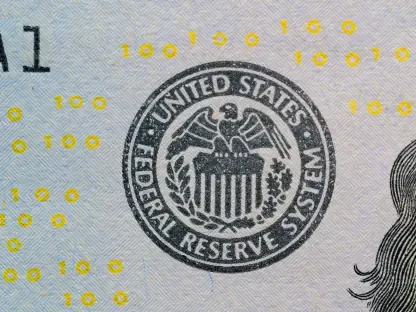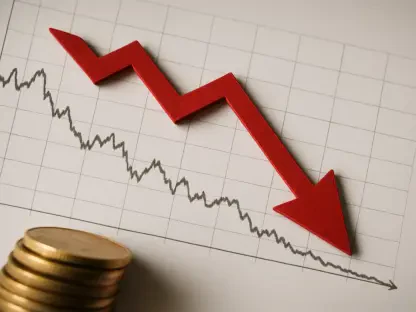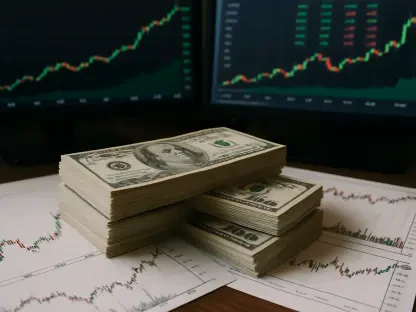The recent announcement of tariffs by President Donald Trump has sparked widespread concern about the potential economic repercussions. Market indices have reacted negatively, raising the specter of a possible recession in the United States. This article delves into the immediate market responses, economic implications, and the diverse viewpoints surrounding these controversial measures. The imposition of a 10% tariff on all imported goods has jolted financial markets, causing significant fluctuations in major stock indices, and reflecting widespread investor anxiety.
Market Reactions and Investor Sentiment
The introduction of a 10% tariff on all imported goods has caused significant declines in major U.S. stock indices, reflecting investor anxiety. The Dow Jones, S&P 500, and Nasdaq all experienced severe drops, with the Dow Jones alone plummeting 1,700 points. This steep decline indicates apprehension among investors about the potential for further economic disruption. Market analysts point to the unpredictability of the tariff announcements as a major factor fueling the negative sentiment. The inconsistency in tariff policies, with frequent revisions and unexpected changes, has made it difficult for investors to make informed decisions. Consequently, many are opting to pull back from the stock market to avoid potential losses.
Moreover, the tariffs have induced a broader sense of uncertainty within the financial markets. The fear that additional tariffs could be imposed without warning has led to increased market volatility. Investors are concerned that a protracted trade war might emerge, leading to long-term negative effects on the global economy. This heightened sense of risk is evident in the significant withdrawal of capital from equities and a shift towards more stable investments such as bonds and gold. This uncertainty is expected to persist, further impacting market confidence and hindering economic growth.
Economic Uncertainty and Trade Policies
Economists argue that the tariffs introduce significant uncertainty into the business environment. Felix Tintelnot from Duke University highlights how the inconsistent nature of the tariffs is causing delays in business investments. Business owners are hesitant to commit to new investments or expansion plans without a clear understanding of the future trade landscape. This hesitation can lead to a slowdown in economic activities, further exacerbating fears of an impending recession.
The additional import taxes imposed based on trade deficits with 60 countries amplify concerns. These unprecedented measures have caused widespread confusion among businesses and economists alike. Many are grappling with the potential long-term consequences for both domestic and global markets. The tariffs, calculated on the basis of trade deficits rather than reciprocal agreements, have left many economists puzzled. This method deviates significantly from established trade policies, complicating efforts to predict the tariffs’ long-term economic impact.
Moreover, the tariffs’ broader economic implications are becoming increasingly apparent. Businesses reliant on imported goods face higher costs, which could lead to increased prices for consumers. This inflationary pressure might reduce consumer spending, a critical driver of economic growth, further contributing to economic uncertainty. Additionally, global trade partners’ retaliatory measures could dampen U.S. export opportunities, leading to a more pronounced economic slowdown.
Impact on Employment and Economic Indicators
Despite the turmoil in the stock markets, employment figures remain robust. The Bureau of Labor Statistics reported that 228,000 jobs were created in March, providing a potential cushion against economic downturns. President Trump has highlighted these positive employment figures as evidence of his policies’ success. He suggests that the tariffs are successfully protecting and creating jobs in American industries previously affected by foreign competition. However, there remains a significant level of apprehension regarding whether job growth can be sustained amidst increasing economic uncertainty and the potential for retaliatory actions from trading partners.
Economists caution that the disconnect between strong employment figures and market instability may not last. While current job growth is a positive indicator, it might not be sufficient to counterbalance the broader economic disruptions caused by the tariffs. The long-term effects on employment could become evident if businesses facing increased costs from tariffs begin to reduce their workforce or halt hiring. Additionally, sectors heavily dependent on exports may experience job losses if retaliatory tariffs lead to reduced demand for U.S. products abroad.
Furthermore, the sustained economic uncertainty could impact consumer confidence and spending, potentially leading to a slowdown in job creation in the future. If consumers start to feel the effects of higher prices resulting from tariffs, their reduced spending could decrease the demand for goods and services, impacting businesses’ ability to maintain or expand their workforce. Thus, while strong employment numbers are encouraging, they may not fully insulate the economy from the broader challenges posed by the tariffs.
Political Perspectives and Reactions
The political response to Trump’s tariffs has been divided. Republicans generally support the tariffs, viewing them as a necessary step to protect American industries and reduce trade imbalances. They argue that these measures will level the playing field for U.S. businesses, which have long been disadvantaged by unfair trade practices. Treasury Secretary Scott Bessent, for instance, believes that the market’s reaction is a short-term phenomenon and that the tariffs will ultimately lead to long-term economic benefits by fostering a more competitive domestic market.
Conversely, Democrats have expressed strong concerns about the potential economic harm. Notably, Senator Adam Schiff criticized the tariffs as self-destructive, pointing out the adverse effects on agriculture and tourism sectors. He argues that the tariffs jeopardize industries critical to the American economy, potentially leading to widespread job losses and economic instability. Democrats highlight the negative ripple effects on consumers, who may face higher prices and reduced availability of goods.
This political divide underscores the contentious nature of the debate surrounding the tariffs. While some advocate for the potential long-term benefits of a more robust domestic economy, others warn of the immediate and tangible risks. The contrasting perspectives reveal a broader ideological clash over the role of protectionist policies in a globalized economy. As this debate continues, the economic implications of the tariffs remain a focal point of political discourse.
Domestic and Global Market Implications
The impact of the tariffs extends beyond U.S. borders, with global markets also experiencing volatility. The decline in the U.S. dollar against the Euro signifies broader economic concerns and the potential for a destabilized global economy. The interconnected nature of global trade means that fluctuations in U.S. policies can have far-reaching consequences. The tariffs have disrupted international supply chains, leading to increased costs for producers and consumers worldwide.
Foreign countries affected by the tariffs, such as China and Brazil, have announced retaliatory measures. This has heightened fears of a trade war, further exacerbating market instability and economic tension. Retaliatory tariffs imposed by these countries affect American exporters, reducing their competitiveness in international markets and potentially leading to decreased demand for U.S. goods.
The escalation of trade tensions poses significant risks for the global economy. A trade war could lead to reduced global trade volumes, slower economic growth, and increased uncertainty for businesses operating in multiple countries. International organizations and economic experts caution that continued escalation could undermine the stability of the global trading system. The fear of a prolonged trade war and its potential impact on economic growth is contributing to the heightened volatility in global financial markets.
Analysis of Tariff Implementation and Effects
Trump’s tariffs are calculated based on trade deficits, a method that has puzzled many economists. Analysts from Yale’s Budget Lab note that the effective U.S. tariff rate is now the highest since 1909, indicating a significant deviation from established trade policies. This historical context highlights the dramatic shift in U.S. trade policy under the current administration. The tariffs aim to boost domestic production and correct trade imbalances, but the implementation’s unpredictability has led to widespread confusion and concern among businesses and investors.
Businesses are struggling to adapt to the rapidly changing trade environment. The frequently shifting tariff policies make it challenging for companies to plan for the future. This unpredictability affects everything from supply chain management to pricing strategies, leading to increased costs and operational inefficiencies. The tariffs’ impact on consumer prices further complicates the economic landscape, potentially leading to inflationary pressures that can reduce consumer purchasing power.
Moreover, the reliance on trade deficits as a basis for tariff imposition raises questions about the long-term effectiveness of these measures. Economists argue that this approach does not address the underlying structural issues in the global trade system. Instead, it risks creating further imbalances and disruptions. The historical precedent set by these tariffs underscores the need for a nuanced and strategic approach to trade policy that considers both domestic and international economic dynamics.
Consumer Sentiment and Economic Outlook
Consumer sentiment has been affected by the tariffs, with many anticipating higher costs and supply shortages, particularly for agricultural products impacted by the import taxes. This decline in consumer confidence could further strain the economy. As consumers adjust to higher prices, their spending habits may change, leading to reduced demand for certain goods and services. This shift can have a cascading effect on the broader economy, impacting businesses’ revenue and potentially leading to slower economic growth.
While strong employment figures offer some solace, the overall economic outlook remains mixed. The juxtaposition of robust job growth with market volatility paints a complex picture of the U.S. economy’s current state. On one hand, the labor market remains resilient, supporting consumer income and spending. On the other hand, the uncertainty introduced by the tariffs continues to weigh on investor confidence and business investment decisions.
The future trajectory of the economy will largely depend on how the situation surrounding the tariffs evolves. If trade tensions escalate further, the negative effects on consumer sentiment and business activities could intensify, potentially pushing the economy closer to a recession. Conversely, if a resolution is reached that reduces uncertainty and stabilizes trade relations, the economy might regain its footing and continue on a path of growth. The coming months will be critical in determining the long-term impact of the tariffs on both the U.S. and global economies.
Conclusion and Review
President Donald Trump’s recent decision to implement tariffs has ignited widespread concern about the economic consequences. His administration announced a 10% tariff on all imported goods, which has already caused significant turmoil in the financial markets. The immediate market response was largely negative, with major stock indices experiencing notable fluctuations. This reaction is a clear indicator of investor unease and the potential for broader economic instability.
The specter of a looming recession now hangs over the United States as the tariffs threaten to disrupt established trade relationships and could lead to higher prices for consumers. Businesses, both large and small, are bracing for the impact, as the cost of importing goods is likely to rise, putting pressure on their bottom lines. This move has sparked a debate among economists, business leaders, and policymakers, with some arguing that the tariffs are necessary to protect American industries and reduce the trade deficit. Others, however, fear that this approach could backfire, leading to a trade war that could stifle economic growth and diminish the nation’s standing in the global market.
In summary, the imposition of a 10% tariff on all imported goods has instilled anxiety in the financial markets, driven by investor concerns and the potential for a recession. The economic implications are far-reaching, and the varied opinions on the effectiveness of these tariffs highlight the complexity of this controversial policy decision.









